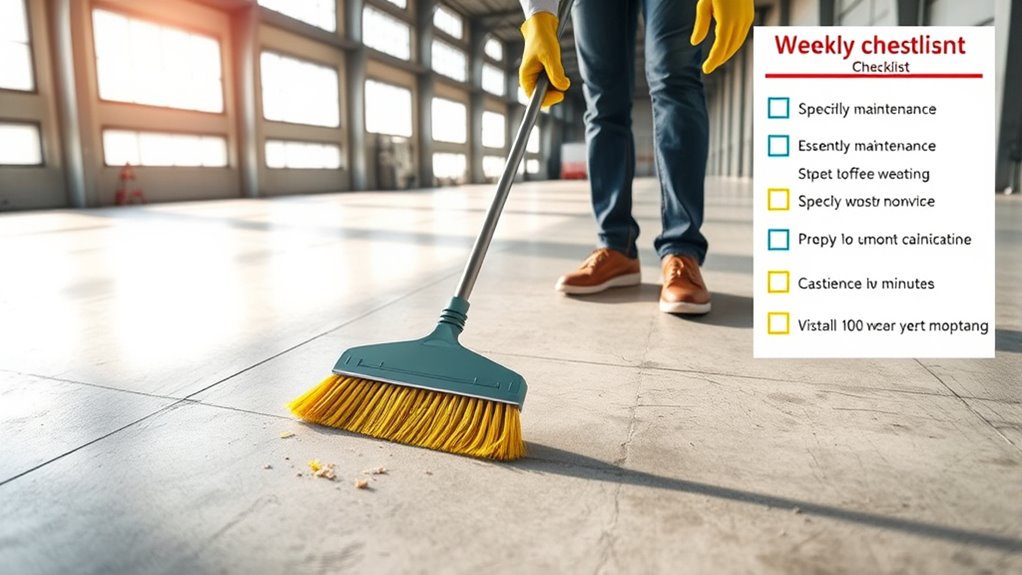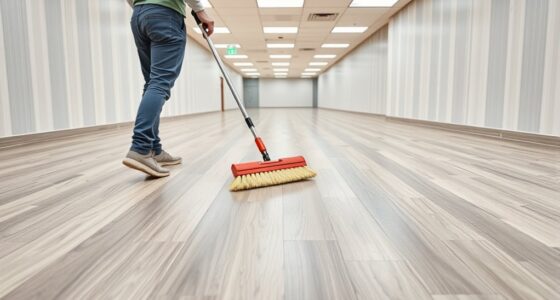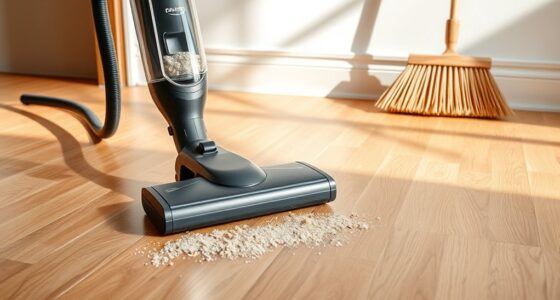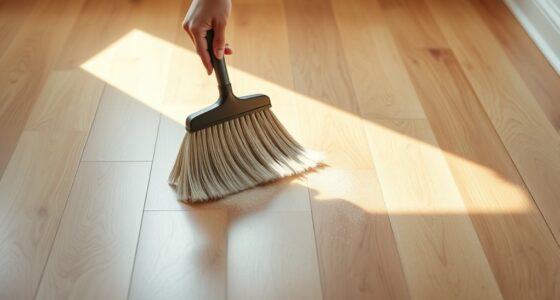To keep your concrete floors in top shape, spend 10 minutes inspecting and maintaining your sweeper. Check brushes for wear or debris buildup, and replace or clean them as needed. Clear dust containers regularly and make sure the equipment operates smoothly. Sweep systematically from corner to corner, paying attention to edges and stubborn spots. Incorporate extra steps for dried mud and control dust to protect your floors. Keep going for detailed tips to make this routine even easier.
Key Takeaways
- Inspect and clean the sweeper’s brushes and debris collection bins to ensure optimal performance.
- Check for and replace worn or damaged brushes to prevent debris scattering.
- Conduct a quick equipment functionality test before starting to sweep.
- Clear dust and debris buildup on the equipment and floor edges for thorough cleaning.
- Follow a consistent routine to maintain equipment and floor condition effectively.
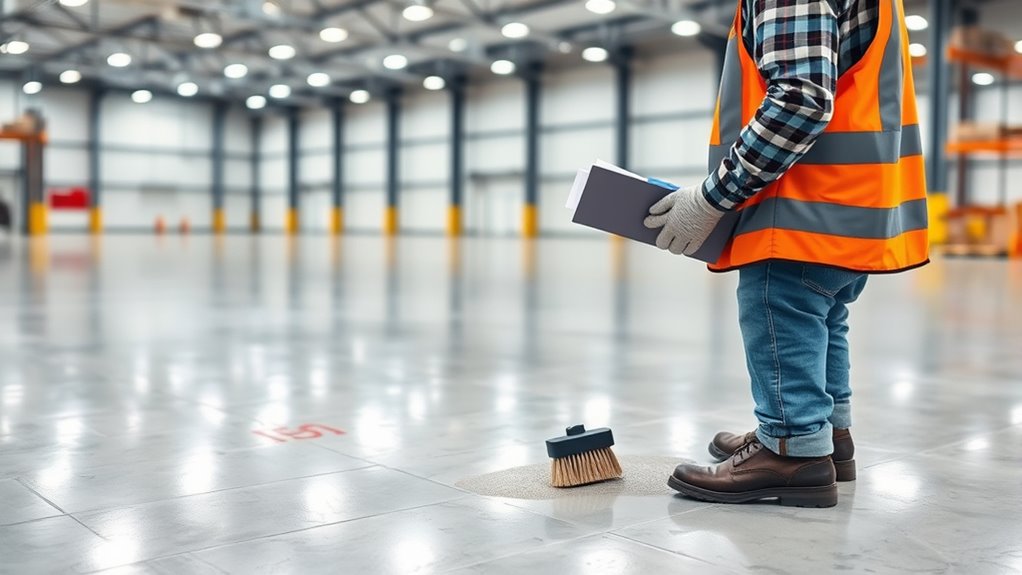
Maintaining your concrete floors is essential to keep them looking their best and lasting longer. A weekly sweeper care routine plays a crucial role in preventing dirt, debris, and dust from accumulating, which can cause surface damage over time. When you focus on proper dust control, you reduce the risk of abrasive particles grinding against the surface, helping to preserve the finish and prevent scratches. Regular sweeping also improves indoor air quality by minimizing airborne dust, making your workspace or facility healthier and more comfortable. To achieve optimal results, you need a simple, consistent checklist that ensures you don’t overlook any important steps.
Start by inspecting your sweeping equipment. Make sure your broom or sweeper is clean and in good condition. Worn or damaged brushes can be ineffective and may scatter debris rather than collect it. Check for any buildup of dirt or debris on the equipment itself, as this can hinder its performance. If you notice worn bristles or other issues, replace or repair your equipment promptly. Proper equipment maintenance is vital because it ensures that your sweeping efforts are efficient, saving you time and effort in the long run. Well-maintained tools also prevent the spread of dirt and dust to other areas, maintaining a clean and safe environment. Additionally, incorporating AI-driven security systems can help monitor your facilities for safety and cleanliness issues remotely.
Next, sweep the entire concrete surface methodically. Start from one corner and work your way across the floor, ensuring you don’t miss any spots. Pay special attention to edges, corners, and along walls where dust tends to settle. Use a push broom or a mechanical sweeper suited to your space size. As you sweep, keep an eye out for any stubborn debris or larger particles that might need additional attention. If your floor has stubborn dirt or dried mud, consider using a slightly damp mop or cloth afterward to lift residues that sweeping alone might miss. This extra step enhances dust control and keeps your floors looking pristine.
Throughout your sweeping routine, stay aware of your equipment’s condition. Regularly clear out the debris collection bin or dust container to prevent clogging and maintain consistent performance. This routine not only improves dust control but also prolongs the lifespan of your equipment. By sticking to this weekly checklist, you help safeguard your concrete floors from unnecessary wear and tear. Consistent, mindful equipment maintenance combined with thorough sweeping ensures your floors stay smooth, clean, and durable for years to come, ultimately saving you money and effort on repairs or refinishing.
Frequently Asked Questions
Can I Use a Regular Vacuum on Concrete Floors?
Yes, you can use a regular vacuum on concrete floors, but make sure it’s compatible with your flooring type. Check the vacuum’s specifications for concrete or hard surface cleaning. You should also consider cleaning frequency; regular vacuuming helps prevent dirt buildup and maintains your floor’s appearance. Use a vacuum with a sturdy brush or beater bar to avoid scratching. This simple step keeps your concrete floors clean and well-maintained.
How Often Should I Replace the Sweeper Bags or Filters?
Think of your vacuum’s filters and bags like the heart of a machine—if neglected, it can slow you down. You should replace sweeper bags when they’re half full or visibly dirty, and change filters every 3 to 6 months for ideal vacuum maintenance. Regular filter replacement keeps suction strong and dust at bay, ensuring your concrete floors stay clean and your vacuum works efficiently longer.
Is It Safe to Use Water-Based Cleaning Solutions?
Yes, it’s safe to use water-based cleaning solutions for your concrete floors. They’re eco-friendly cleaning options that reduce chemical safety concerns, making them ideal for regular use. Just guarantee the water-based cleaner is suitable for your specific floor type and follow the manufacturer’s instructions. This approach helps maintain a clean, safe environment while protecting the concrete from damage and supporting eco-friendly cleaning practices.
How Do I Prevent Dust Buildup Between Cleanings?
To prevent dust buildup between cleanings, focus on dust prevention and improving air circulation. Regularly sweep or vacuum your concrete floors to remove loose dust and debris. Use air purifiers or ensure proper ventilation to keep dust particles from settling. Maintain good airflow, especially in enclosed spaces, to help sweep away dust before it accumulates. These steps promote a cleaner environment and reduce the frequency of deep cleanings needed.
What Are the Signs That My Sweeper Needs Repair?
You notice your sweeper malfunctioning when it struggles to pick up debris or leaves streaks behind. Unusual noises, decreased suction, or uneven brush rotation are clear signs it’s time for inspection. If you experience frequent clogging or if parts seem worn out, these are replacement indicators. Catching these signs early helps prevent further damage, ensuring your sweeper continues to perform efficiently and saves you from costly repairs down the line.
Conclusion
By following this simple 10-minute checklist each week, you’ll keep your concrete floors looking as pristine as a mirror and prevent costly damage. Regular sweeping and maintenance are your secret weapons against dirt and debris, ensuring your floors stay durable and beautiful for years to come. Think of it as giving your floors a mini spa treatment—refreshing, revitalizing, and absolutely essential to keep them in top shape. Don’t wait—your floors will thank you with a lifetime of flawless performance!
